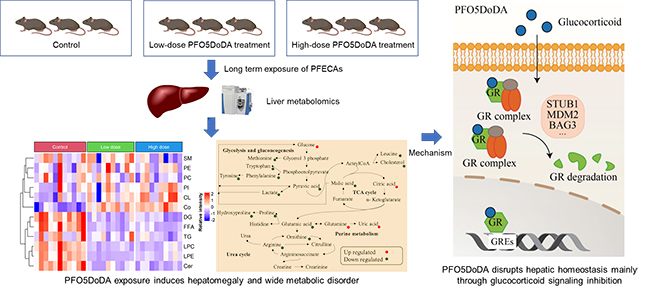Per- and polyfluoroalkyl substances (PFASs), a class of chemicals, are featured with hydrophobicity, lipophobicity, and thermal stability. Since the 1950s, they have been widely used in a wide range of industrial and consumer products.
However, PFASs' bioaccumulation and toxicity in wildlife and humans restrict their applications. Next-generation PFASs such as perfluoroether carboxylic acids (PFECAs) are needed to replace conventional PFASs. Nevertheless, information regarding their possible environmental and human health risks is limited.
Recently, a research group led by Prof. XU Guowang from the Dalian Institute of Chemical Physics (DICP) of the Chinese Academy of Sciences (CAS), in collaboration with Prof. WANG Jianshe from Yantai University, revealed the toxic effects of PFECAs to mice.
This study was published in Journal of Hazardous Materials on Jan. 20.

Illustration of the toxic effects and the mechanism of PFO5DoDA in this study (Image by YANG Jun and Liu Xinyu)
The researchers explored the effects of PFECAs on mice based on long-term exposure to environmentally relevant doses of perfluoro-3,5,7,9,11-pentaoxadodecanoic acid (PFO5DoDA), and revealed that PFECAs exposure suppressed many cellular stress signals and resulted in hepatomegaly.
They found that PFO5DoDA acted as an agonist of the peroxisome proliferator-activated receptor (PPAR) in vitro and modulated PPAR-dependent gene expression in the liver. In addition, PFECAs had an inhibitory effect on the glucocorticoid receptor (GR), which might contribute to suppression of stress signals. GR suppression induced by PFECAs was not found in conventiperfluorooctanoic acid (PFOA).
Through liver metabolomics analysis, the researchers found that PFO5DoDA-induced changes in both GR and PPAR signals remodeled hepatic metabolic profiles, including decreased fatty acids and amino acids and increased β-oxidation.
"Our work highlights the potential risk of PFECAs to human and wildlife health," said Dr. LIU Xinyu, corresponding author of this study.
This work was supported by the National Key Research and Development Program of China, the National Natural Science Foundation of China, and the Youth Innovation Promotion Association of CAS.